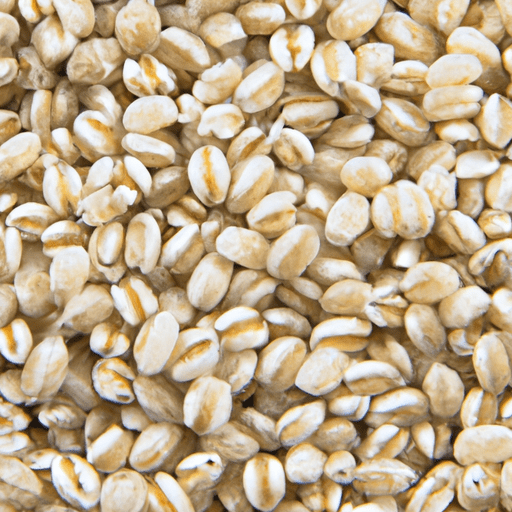The Delightful World of Cooked Pearled Barley: Nutritious, Versatile, and Delicious!
Cooked pearled barley is a culinary gem that has been enjoyed by food enthusiasts for centuries. With its unique texture, nutty flavor, and remarkable versatility, it has become a staple ingredient in many cuisines across the globe. In this blog post, we’ll delve into the details of cooked pearled barley, including its taste, common uses in cooking, nutritional value, and even a bit of interesting history. So, let’s get started!
The Taste of Cooked Pearled Barley
When cooked to perfection, pearled barley boasts a pleasant, chewy texture and a subtly nutty flavor. Its mild taste allows it to absorb the flavors of other ingredients, making it a fantastic addition to a wide range of dishes. Whether it’s soups, stews, salads, or grain bowls, cooked pearled barley adds depth and character to any culinary creation.
Common Uses in Cooking
Cooked pearled barley is highly versatile and can be used in a variety of ways. Here are a few common uses:
- Soups and Stews: Pearled barley is often used to add heartiness and thickness to soups and stews. Its starchiness releases during cooking, creating a velvety texture and a delightful silkiness to the broth.
- Salads: Cooked pearled barley makes a fantastic base for salads. Its chewy texture pairs perfectly with crisp vegetables, creamy dressings, and tangy vinaigrettes, elevating any salad to a whole new level.
- Risotto-like Dishes: While not a traditional risotto grain, cooked pearled barley can be used as a delicious and healthier alternative to rice. Its creamy consistency and ability to absorb flavors make it an excellent choice for experimenting with new recipes.
- Side Dish: Served simply as a side dish, cooked pearled barley adds substance and variety to any meal. It can be seasoned with herbs, spices, or even a dash of lemon juice to complement the main course.
Nutritional Value
Cooked pearled barley not only tantalizes your taste buds but is also packed with nutritional goodness. Here are some of its health benefits:
- Fiber: Pearled barley is an excellent source of dietary fiber, promoting healthy digestion and aiding in weight management.
- Protein: It contains a fair amount of protein, making it an attractive choice for vegetarians and vegans looking to increase their protein intake.
- Vitamins and Minerals: Pearled barley contains essential vitamins and minerals, including iron, magnesium, manganese, and B vitamins, contributing to overall health and vitality.
- Low Fat: It’s low in fat and cholesterol-free, making it a heart-healthy choice for those watching their saturated fat intake.
A Brief History & Fun Facts
Barley, the main ingredient in pearled barley, has a rich history dating back thousands of years. It was one of the first cultivated grains, prominently consumed in ancient Egypt and Mesopotamia. In fact, archaeological evidence suggests that barley has been consumed for over 10,000 years!
In more recent years, pearled barley has gained popularity as a wholesome and nutritious grain option. Although it does undergo some processing, the outer husk, bran, and germ are removed, resulting in the pearled form we now commonly use for cooking. This process helps reduce cooking time while preserving much of the grain’s nutritional value.
Fun fact: Did you know that pearl barley got its name from the process of “pearling”? It involves polishing the grains by abrasion to remove the outer layers and create a pearly white appearance.
Conclusion
Cooked pearled barley is an ingredient that offers both culinary satisfaction and nutritional benefits. Its delightful taste, versatility in cooking, and health-promoting properties make it an excellent addition to anyone’s pantry. So go ahead, experiment with recipes, and embrace the unique qualities of cooked pearled barley. Your taste buds and body will thank you for it!
Cooked Pearled Barley
Origin: Barley is one of the oldest cultivated grains, with a history dating back thousands of years. It is believed to have originated in the Near East and played a significant role in ancient Egyptian, Greek, and Roman civilizations.
Common Uses: Cooked pearled barley is a versatile grain that is commonly used as an ingredient in soups, stews, and salads. It can also be used as a side dish, similar to rice or couscous. The chewy texture and nutty flavor of cooked pearled barley make it a popular addition to various dishes.
Nutritional Benefits: Cooked pearled barley is packed with several essential nutrients. It is a good source of fiber, providing approximately 6 grams per cooked cup. Barley also contains important minerals like manganese, magnesium, and phosphorus. Additionally, it is a decent source of vitamins, including vitamin B3, vitamin B6, and folate.
Unique Properties: Pearled barley refers to the removal of the outer husk, bran, and germ layers, resulting in a polished grain. This process makes pearled barley quicker to cook but also removes some of the fiber and nutrients found in the whole grain barley. The pearled variety has a milder flavor compared to the whole grain barley.
Historical Significance: Barley has played a significant role in human history. In ancient times, it was a staple food for many civilizations, often used as a form of currency. Barley grains have been discovered in Egyptian tombs dating back over 4,000 years. Barley was used to make beverages like beer in ancient Mesopotamia, and it was also a vital crop for feeding both humans and animals.




Use the share button below if you liked it.
It makes me smile, when I see it.